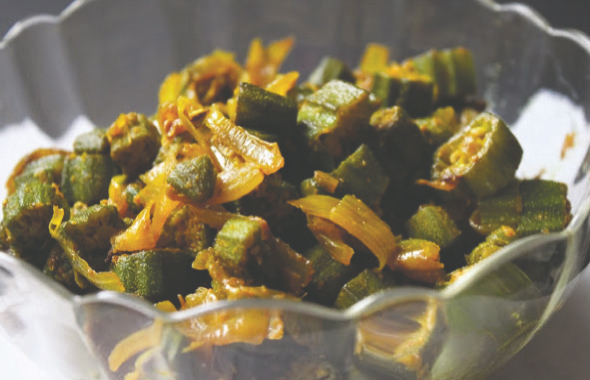Mama’s Punjabi Recipes — Katti Bhindi (Sauteed Cut Okra)

During the warm months, the bazaars and markets are overflowing with a huge variety of all sorts of vegetables. King among them are the two that together bring out the hearty taste and earthy smells of the Punjabi soil: karele (bittermelon gourd) and bhindis (okra). During these months, hawkers sell wicker baskets full of these two vegetables and many homes eat them regularly.
If you have never seen the plants, while the karela plant is a vine with small leaves and the bhindi is a bush with large leaves, both have pretty yellow flowers. The large ones of the bhindi plant furl open and close everyday and have a black stalk in the middle.
Just like karele, bhindi is also cooked either chopped up or slit and stuffed with spices and sautéed in a wok or kadai. Both share a common cooking style in that both have dark green coloration, with a firm outer skin that becomes tender when cooked, and both are made with small, whole onions.
Okra is high in fiber, vitamin C, folate and antioxidants. It is also a good source of calcium and potassium. Greenish-yellow edible okra oil is pressed from okra seeds; it has a pleasant taste and odor, and is high in unsaturated fats such as oleic acid and linoleic acid.
Though many people cook bhindis, the Punjabi style is to make them dry and not with the stickiness that comes when some water has been added to it. The secret to good bhindi sabzi (okra dish) is to make sure that the vegetable is completely dry before it is chopped and it is cooked uncovered so that the steam from the vegetable does not ooze into the dish and make it sticky.
Ingredients:
• 250 gm bhindi (medium thickness okra)
• 2 medium pyaaz (onion) peeled and cut into half inch slices
• 2 tablespoon tael (vegetable or olive oil)
• 1 teaspoon haldi (turmeric)
• Spices (to taste): namak (salt), mirch (red pepper), dhania (ground coriander), garam masala, amchoor (mango powder)
Directions:
1. Wash the okra and leave it to drain in a sieve. Spread out each pod on a soft cloth and pat dry. If you are in a hurry, then instead of washing the bhindi, clean each pod with a slightly damp soft cloth.
2. It is very important NOT to have any water enter the dish before chopping and while cooking otherwise the dish will come out soft, mushy and sticky.
3. Cut off the stems and the pointy bottoms (I like to say “sar aur poonch” or head and tail!) then cut the okra into half-inch long pieces.
4. In a kadai (wok) or skillet, heat the oil well, throw in the turmeric and the okra and stir well for five minutes over high heat till the okra is coated on all sides. Cover for five minutes, then remove and be careful to drain off the steam on the inside of the cover in the sink and NOT in the dish.
5. Turn the heat to low and cook while stirring gently so that the okra is not smashed. When the okra is tender to the touch, throw in the onions and the rest of the spices and mix well but gently. Do NOT add the salt just yet otherwise the okra will release water and become mushy and sticky.
6. Reduce the heat to extreme low and stir occasionally for ten minutes then turn off the heat. Keep uncovered till the dish has cooled down. You can NOW add the salt and garam masala to taste.
 Shakuntla Malhotra is a skilled cook of Punjabi dishes made in the old-fashioned style that she learnt as a young woman in her ancestral home in Lyallpur, India before it became part of Pakistan after the Partition in 1947. People have often admired her cooking for its simplicity and taste that comes with each mouthful. Even in her mid-eighties, she continues to cook daily and agreed to share some of her delectable Punjabi recipes.
Shakuntla Malhotra is a skilled cook of Punjabi dishes made in the old-fashioned style that she learnt as a young woman in her ancestral home in Lyallpur, India before it became part of Pakistan after the Partition in 1947. People have often admired her cooking for its simplicity and taste that comes with each mouthful. Even in her mid-eighties, she continues to cook daily and agreed to share some of her delectable Punjabi recipes.
